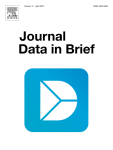Ver ítem
- xmlui.general.dspace_homeCentros e Institutos de InvestigaciónCICVyA. Centro de Investigación en Ciencias Veterinarias y AgronómicasInstituto de BiotecnologíaArtículos científicosxmlui.ArtifactBrowser.ItemViewer.trail
- Inicio
- Centros e Institutos de Investigación
- CICVyA. Centro de Investigación en Ciencias Veterinarias y Agronómicas
- Instituto de Biotecnología
- Artículos científicos
- Ver ítem
Dataset on absorption spectra and bulb concentration of phenolic compounds that may interfere with onion pyruvate determinations
Resumen
We present data on absorption spectra (400–540 nm) and concentration of phenolic compounds quercetin, myricetin, kaempferol, rutin, catechin, epicatechin gallate(ECG) and epigallocatechin gallate (EGCG), inyellow, redand whit eonions.These data are related to the article entitled “Variability inspectrophotometric pyruvate analyses for predicting onion pungency and nutraceutical value” (Berettaetal.,2017) [1]. Given the relevance of pyruvate determinations
[ver mas...]
We present data on absorption spectra (400–540 nm) and concentration of phenolic compounds quercetin, myricetin, kaempferol, rutin, catechin, epicatechin gallate(ECG) and epigallocatechin gallate (EGCG), inyellow, redand whit eonions.These data are related to the article entitled “Variability inspectrophotometric pyruvate analyses for predicting onion pungency and nutraceutical value” (Berettaetal.,2017) [1]. Given the relevance of pyruvate determinations for estimating onion pungency and functional value, it is important to identify compounds that can interfere with pyruvate determinations when using two previously published analytical procedures, namely Schwimmer and Weston(1961) (SW) [2] and Anthon and Barret(2002)(AB)[3], which are based on spectrophotometry and light-absorbanceat 420 nm and 515 nm, respectively. The data presented in this article are absorption spectra for 7 onion phenolic compounds in the range 400–540 nm, which include wavelengths used by the two pyruvate analytical methods (Schwimmer and Weston,1961; Anthon and Barret, 2002)[2,3] that were compared in our reference article (Beretta et al.,2017) [1]. Additionally, bulb content data for these 7 phenolic compounds in onion cultivars and F2 progenies with different bulb color were included to allow further analyses.
[Cerrar]

Autor
Beretta, Hebe Vanesa;
Bannoud, Florencia;
Insani, Ester Marina;
Galmarini, Claudio Romulo;
Cavagnaro, Pablo;
Fuente
Data in brief 11 : 208-213. (2017)
Fecha
2017
ISSN
2352-3409
Formato
pdf
Tipo de documento
article
Palabras Claves
Derechos de acceso
Abierto
 Excepto donde se diga explicitamente, este item se publica bajo la siguiente descripción: Creative Commons Attribution-NonCommercial-ShareAlike 2.5 Unported (CC BY-NC-SA 2.5)
Excepto donde se diga explicitamente, este item se publica bajo la siguiente descripción: Creative Commons Attribution-NonCommercial-ShareAlike 2.5 Unported (CC BY-NC-SA 2.5)


